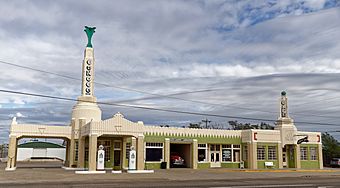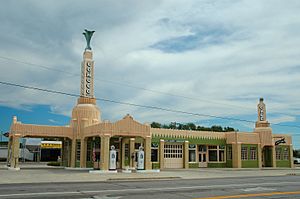U-Drop Inn facts for kids
|
Tower Station
|
|

The U-Drop Inn (2018)
|
|
| Location | 101 E. 12th Street, Shamrock, Wheeler County, Texas |
|---|---|
| Area | less than one acre |
| Built | 1936 |
| Architect | multiple |
| Architectural style | Art Deco |
| NRHP reference No. | 97001160 |
Quick facts for kids Significant dates |
|
| Added to NRHP | September 18, 1997 |
The U-Drop Inn, also known as Tower Station, is a famous building in Shamrock, Texas. It was built in 1936 along the historic Route 66. The building's unique design was inspired by a simple idea: a nail stuck in the ground.
The building is a special example of Art Deco architecture, a style known for its bold geometric shapes and bright colors. It has two tall towers, shiny tile walls, and glowing neon lights. For many years, it was home to two businesses. One side was the "Tower Station" gas station, and the other was the "U-Drop Inn" café.
When Route 66 was replaced by newer highways, the U-Drop Inn was forgotten and fell into bad shape. But because of its cool design, it was saved. The building was added to the National Register of Historic Places in 1997. It was then given to the city of Shamrock.
Using a $1.7 million grant from the government, the city restored the building to look like it did in its best days. Today, it serves as a museum, a visitor center, and the city's chamber of commerce. The building's design also inspired a location in the 2006 animated movie Cars. Ramone's automotive shop in the fictional town of Radiator Springs looks just like the U-Drop Inn.
Contents
History of the U-Drop Inn
A Unique Beginning
The U-Drop Inn opened on April 1, 1936. The idea for its design came from a man named John Nunn. He simply scratched a drawing of a nail in the dirt to show his idea. An architect named J.C. Berry then created the official plans for the building.
The building was located at a busy corner where two major highways, Route 66 and U.S. Route 83, crossed. To find a name for the new place, the owners held a contest. An eight-year-old boy won with his suggestion, "U-Drop Inn."
When it opened, a local newspaper called it "the most up-to-date" building of its kind between Oklahoma City and Amarillo. The café was described as very fancy. At the time, it was the only café for 100 miles, so it was very popular and successful.
Over the years, the building was sold several times. In 1957, it was renamed the Tower Café and even had a Greyhound bus station inside.
Hard Times and Decline
In 1956, the U.S. government began building a new system of major roads called Interstates. This meant that fewer people traveled on the old Route 66. Towns like Shamrock were bypassed, and businesses like the U-Drop Inn started to lose customers.
By the 1980s, the building was bought by the son of the man who first paid for its construction. He painted it back to its original colors and gave it its original name. But by the mid-1990s, the business closed down completely. The once-beautiful building was left empty and began to fall apart.
Restoration and a New Life
Even though it was in bad shape, many people still thought the U-Drop Inn was special. The Texas Historical Commission called it "one of the most impressive examples" of Route 66 architecture. In 1997, it was added to the National Register of Historic Places, a list of important historic sites in the United States.
In 1999, a local bank bought the U-Drop Inn and gave it to the city of Shamrock. The city wanted to save the building and turn it into a tourist attraction. They hired experts in historical preservation to restore it.
The restoration team used old photos and interviews with local people to make sure every detail was right. They carefully uncovered the original paint colors. One of the hardest parts was figuring out the colors of the original neon lights, since all the old photos were taken during the day.
The project cost $1.7 million and was finished in 2003. The old gas station and café were turned into a visitor center and museum about the building's own history. In 2014, the café area began serving drinks again. As of 2025, the U-Drop Inn café is open and serves classic American food. A popular spot in the cafe is a booth where the famous singer Elvis Presley once sat.
Architecture and Design
The U-Drop Inn is a great example of the Art Deco style. This style was usually used for big city buildings, so seeing it on a small roadside gas station and café is very rare.
The building is made of concrete and brick, with shiny glazed tiles. It has a flat roof and two towers that grab your attention.
- The Gas Station Tower: The taller tower is on the west side, over the gas station. It looks like a four-sided pillar, or obelisk, and has a metal "tulip" shape at the very top. The word "Conoco," the brand of gas originally sold there, was written on each side.
- The Café Tower: The shorter tower is on the east side, over the café. It has "Café" written on it in a similar style.
Both towers were designed to attract drivers passing by on the busy highway. They have geometric patterns and were outlined with bright neon lights, which made the building stand out, especially at night.
The building was split into two businesses. The west side was the Tower Station, with fuel pumps under two canopies. The east side was the U-Drop Inn café, which had booths for customers and a kitchen in the back. The outside of the building is painted beige with dark green details, just like it was originally.
See also




